ALT. FUELS
Hanwha and Baker Hughes Partner for New Carbon-Free Ammonia Gas Turbines
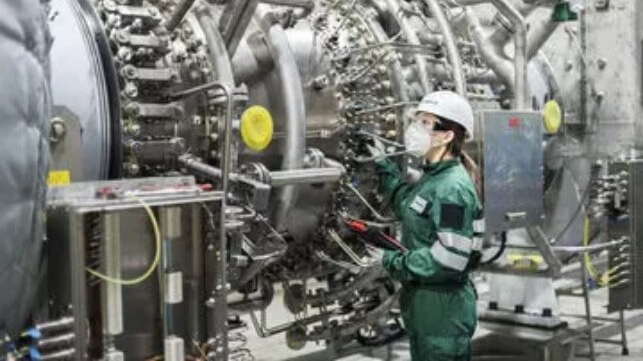
Hanwha Group through its shipbuilding and power systems divisions is partnering with energy technology company Baker Hughes to develop a new generation of small-size ammonia gas turbine engines. By using the proven design of gas turbines, the companies believe it will be possible to develop a new engine that can unlock the benefits of ammonia to provide carbon-free emissions in new applications including shipping.
Baker Hughes offers a broad line of gas turbines ranging from 5.7MW to 130MW which it highlights cover virtually every application across the oil and gas value chain, and in other industries. Power plants, LNG, and pipeline transmission, the company reports have widely adopted its gas turbine products and now it looks to develop the new small-size ammonia turbine which will be suitable for marine applications as well as for onshore and offshore applications and electric generation and mechanical drive. Gas turbines were explored for several ships including cruise ships starting about 20 years ago, but many cruise lines moved away from them saying they are costly to operate.
Under the new partnership, Baker Hughes will work with the shipbuilding group Hanwha Ocean and Hanwha Power Systems. They look to combine expertise for a new small-size turbine for ammonia applications that will leverage Baker Hughes’ small-size gas turbine technology and Hanwha’s ammonia combustion system.
Hanwha reports it has already tested successfully a proof-of-concept of the combustor, with 100 percent ammonia as the fuel gas, and Baker Hughes completed its initial turbine feasibility studies in 2024. The two companies target to complete the full engine test with ammonia by the end of 2027, after which the turbine (~16MW power range) will be commercially available for orders.
"This collaborative development of a low-carbon ammonia gas turbine will be a significant turning point in the global shipbuilding and shipping industry, accelerating the transition to eco-friendly fuel propulsion for ships," said Son Young-chang, vice president and head of Hanwha Ocean's Product Strategy Technology Institute.
The ammonia gas turbine to be developed through this collaboration will be based upon the proven, small-size turbine technology of Baker Hughes, and a newly-developed ammonia combustion system created by PSM, a US-based Hanwha subsidiary. The gas turbine will be capable of 100 percent ammonia combustion, and dual fuel operation with a natural gas and ammonia blend.
“It is expected to be a game-changing technology for large ship owners, enabling a completely carbon-free mode of propulsion,” predicts Hanwha. The shipbuilding group looks to incorporate the ammonia gas turbine into its designs for LNG gas carriers and containerships which it expects to have available by 2028. Hanwha Power Systems and Hanwha Ocean obtained in September 2023 approval in principle from the American Bureau of Shipping (ABS) to apply ammonia gas turbines to LNG carriers.
Baker Hughes reports that it is currently exploring how its small-size gas turbines can accelerate the transition from diesel motors to turbines powered by ammonia and hydrogen. In January 2024, the company announced the completion of the successful testing of the world’s first 100 percent hydrogen turbine, which is now commercially available and with orders under execution
Project to Develop High-Power Methanol Fuel Cells Targeting Cruise Ships
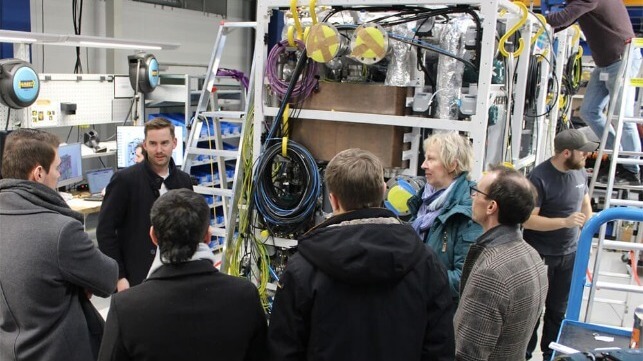
A new project uniting leaders in German industry and funded by the German government looks to develop a new generation of fuel cells using methanol to provide power for cruise ships. In the zero4cruise project, the German Aerospace Centre (DLR), will be working with Meyer Werft and the Freudenberg Fuel Cell e-Power Systems, to further develop PEM fuel cell technology for large-scale maritime systems.
The partners highlight that the project is designed to tackle one of the maritime industry’s most pressing challenges, the development of sustainable and low-emission energy solutions for cruise ships. Several smaller-scale projects are working on fuel cells for cruise ships and demonstration projects, but the challenge is the amount of power required to sustain the operations of a large cruise ship. The project looks to build on existing technology to create large-scale fuel cell stacks.
Meyer, which is well-known for its large cruise ship constructions including the first LNG dual-fuel ships, notes the focus of this project is on retrofitting existing ships. In addition to extending the lifespan of current ships, they note it can accelerate the decarbonization process in the cruise sector. They are particularly focusing on sustainable operations in ports and coastal areas.
A key focus of the project is the further development of PEM (Proton Exchange Membrane) fuel cell systems for large-scale maritime applications. They note by combining with methanol as an energy carrier, this technology offers great potential for supplying ships with electricity, heat, and cooling - efficiently and with low emissions.
The DLR Institute of Engineering Thermodynamics is responsible for the pre-development of fuel cell stacks on a scale relevant to the maritime market. This includes the consistent implementation of innovative technology approaches in the field of both LT-PEM and HT-PEM. The aim is to build prototype fuel cell stacks with 250 kW (LT-PEM) and 120 kW (HT-PEM), including performance verification in the laboratory.
The DLR Institute of Maritime Energy Systems is carrying out long-term tests on a 500 kW maritime fuel cell system. The aim is to simulate the real load cycles of a cruise ship to prove the long-term suitability of the system. In addition, newly developed LT and HT PEM fuel cell stacks will be tested in the Maritime Energy Laboratory to ensure development to the system level.
The German Federal Ministry of Economics and Technology funded the project with a total of €18.7 million ($193 million). The research project kicked off in January with a team meeting in Munich.
Econowind Passes 100th VentoFoil Unit Sold
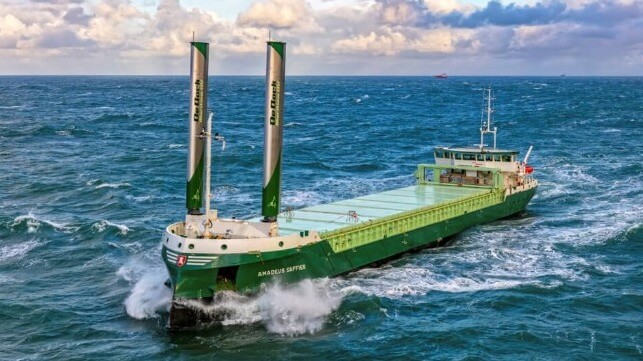
[By: Econowind]
Growing adoption of Wind-Assisted Ship Propulsion for sustainable shipping
Econowind has surpassed 100 VentoFoil units sold, marking a major milestone in the shipping industry’s shift towards Wind-Assisted Ship Propulsion. The increasing adoption of the VentoFoil system reflects shipowners’ drive to cut fuel consumption, reduce CO? emissions, and comply with tightening global regulations.
Since the first two units were installed on MV Ankie in 2018, Econowind has steadily expanded its reach. Today, 32 VentoFoil units are in operation, 33 are currently in production or ready for installation, and another 37 are set for delivery in 2025. The VentoFoil technology has been successfully deployed on bulk carriers, tankers, RoRo, and container vessels.
“Surpassing 100 VentoFoil units sold is a clear sign that Wind-Assisted Ship Propulsion is gaining real momentum,” said Chiel de Leeuw, CCO of Econowind. “With rising fuel costs and increasingly strict environmental regulations, shipowners are embracing wind power as a proven solution. As we scale up production, we’re eager to help even more vessels transition to greener shipping. The low weight and tiltable VentoFoils are ideal for ship owners who value flexibility.”
Ramping up production in Zeewolde
To meet growing demand, Econowind is scaling up production at its facility in Zeewolde. The expanded space and optimized processes allow for higher output and shorter lead times, ensuring more shipowners can benefit from VentoFoil technology. This strategic move positions Econowind to ramp up manufacturing as the industry accelerates its shift toward low-carbon shipping solutions.
The VentoFoil Family
The VentoFoil range offers flexible solutions with 10m, 16m, 24m, and 30m versions, catering to various vessel sizes and operational needs. Next to the fixed mounts Econowind offers containerized and Flatrack VentoFoil units. These can be easily transferred between vessels, making it a practical, scalable solution for shipowners looking to enhance efficiency and reduce carbon emissions while maintaining operational flexibility.
A solution for compliance: The Wind Reward Factor
From 2025, FuelEU Maritime will tighten CO? reduction targets, rising from 2% to 80% by 2050. Shipowners using VentoFoil technology benefit from the Wind Reward Factor (WRF), which lowers their vessel’s reported emissions, making compliance with FuelEU Maritime, CII, and ETS regulations easier and more cost-effective. By integrating VentoFoils, they reduce fuel costs, cut carbon allowance expenses, and improve
The products and services herein described in this press release are not endorsed by The Maritime Executive.
WinGD On-Engine NOx Abatement Solution to Make Commercial Debut
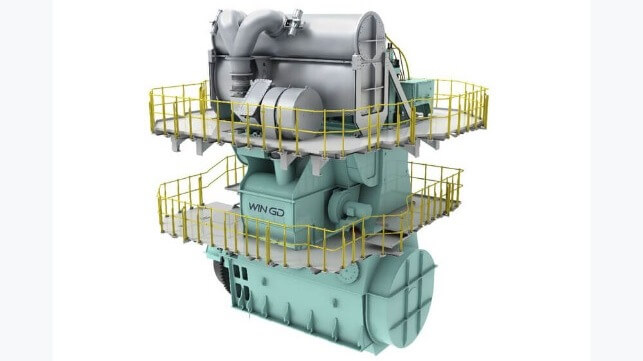
[By WinGD]
The only on-engine NOx reduction solution for marine two-stroke engines, designed by Swiss marine power company WinGD, will be deployed for the first time on commercial engines after securing type approval. The integrated Selective Catalytic Reduction (iSCR) solution was tested at Mitsui E&S DU (MESDU) Co’s factory in Aioi, Japan, where three WinGD 5X52-S2.0 engines are being built for bulk carriers under construction at a Japanese shipyard.
The type approval follows more than two years of service experience with a prototype version. The latest iteration features reduced material and production costs, a heating unit to enable operation with heavy fuel oil and design changes to deliver further reductions in ammonia slip.
WinGD Vice President Product Centre, Peter Krähenbühl, said: “WinGD’s unique on-engine NOx abatement solution secures IMO Tier III compliance while giving operators greater flexibility in engine room configuration and ship design. This new iteration further reduces the cost impact of NOx abatement and improves the efficiency of treatment with both existing and emerging fuels.”
As well as reducing the footprint of off-engine equipment, iSCR also simplifies piping requirements compared to either low- or high-pressure SCR off-engine units. Testing and commissioning are simplified as the engine and NOx abatement system can be tested together prior to installation. Optimised exhaust flow management and waste heat from the engine contribute to favourable conditions for treatment.
The test was held on January 16th and was witnessed by representatives from eight leading classification societies: ABS, BV, CCS, DNV, KR, LR, ClassNK and RINA.
The iSCR technology is available as an option for WinGD’s 52- and 62-bore engines, including short-stroke variants, using fuel oil, ammonia or methanol. Extension to further engines will be evaluated based on market demand.
The products and services herein described in this press release are not endorsed by The Maritime Executive.
Corvus ESS Will Power the World’s First Fully Electric Offshore Vessel
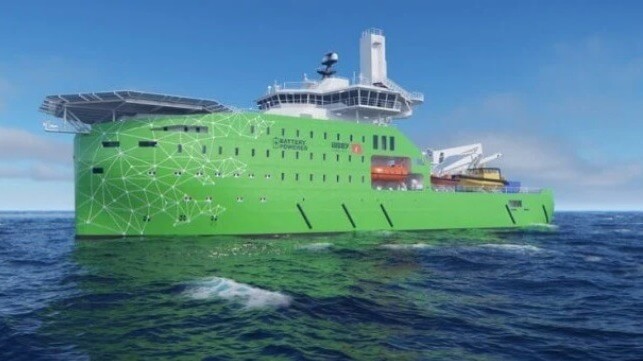
[By Corvus Energy]
Corvus Energy, the leading supplier of zero emission solutions for the offshore and marine industry, is proud to announce that it will deliver a mega-size battery system for the first fully electric offshore vessel ever to be built.
The vessel is an electric Commissioning Service Operation Vessel (eCSOV) that will be constructed by Armon shipyard in Spain for the UK-based shipowner Bibby Marine Ltd.
World`s first of its kind
Corvus Energy will supply its Blue Whale Battery Energy Storage System (BESS) delivering close to 25MWh of power for the vessel. It will be the largest LFP (Lithium Iron Phosphate) battery system ever delivered to a maritime project.
“A fully electric offshore vessel is something the industry has been working towards for a long time and marks a major milestone in offshore vessel operations," said Pål Ove Husoy, VP Sales at Corvus Energy.
“This eCSOV will be the first offshore vessel that can operate fully electric for a full day and will set a new standard for future offshore vessels. The unique system design incorporating both battery power and dual-fuel methanol engines will significantly reduce carbon emissions and increase energy efficiency while providing the reliability and performance needed for demanding offshore wind and renewable operations.”
Unique and optimized power distribution system
Corvus Energy has been cooperating closely with the shipowner, designer and integrator to dimension and optimize the system design. Unlike conventional hybrid systems, the vessel will utilize its large battery pack as the primary power source, with engines running solely for charging at a constant, optimized load that maximizes efficiency, extends battery lifespan and significantly reduces emissions. The innovative DC grid architecture further enhances overall system performance by minimizing energy losses and ensuring seamless power distribution. Additionally, offshore charging capabilities will enable simultaneous battery charging while maintaining DP for station-keeping, representing an industry first in the SOV market.
Accelerating the path to net zero
Gavin Forward, New Build Director at Bibby Marine, commented: “We are excited to collaborate with Corvus on this pioneering eCSOV project, setting a new benchmark for sustainable offshore operations and driving the future of zero-emission vessel technology."
He added that Bibby Marine selected Corvus Energy "for its proven track record in delivering complex vessel projects, while the LFP battery chemistry was chosen for its alignment with our eCSOV’s operational profile, offering enhanced safety, longevity and reliability for a project that promises to accelerate the path to net-zero for the maritime sector."
Equipment from Corvus Energy will be delivered to the shipyard in 2026, and the vessel is scheduled for operation in 2027 supporting the commissioning and operation of windfarms.
The products and services herein described in this press release are not endorsed by The Maritime Executive.
No comments:
Post a Comment